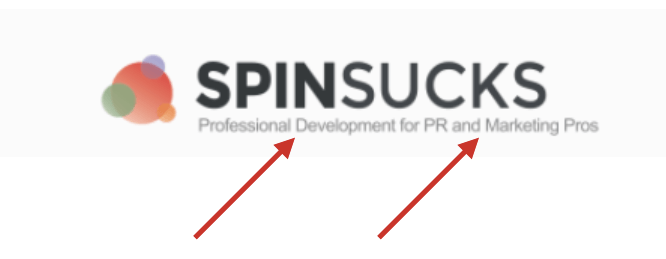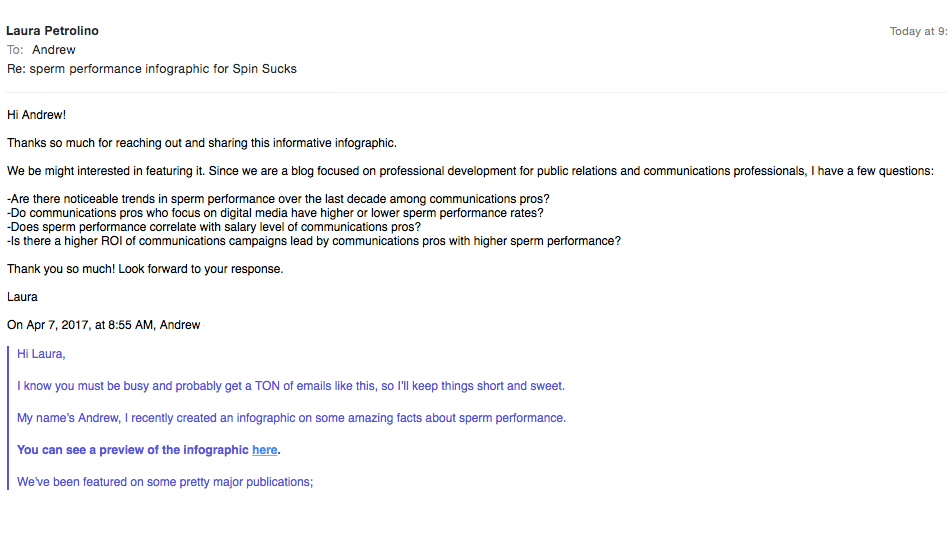 Imagine you are the head of the communications team for a sperm testing company.
Imagine you are the head of the communications team for a sperm testing company.
(Yes, sperm testing, stay with me here, this will all come together.)
You are tasked with earned media efforts and ways you can get the word out about your company to the people who need your testing capabilities.
You think about creative ways to create interesting content.
Content which speaks to your brand, but the kind people still want to read.
You brainstorm with your team something you can use as an anchor to get attention of influencers and place content on high authority sites.
Finally you decide on an infographic which outlines some super interesting facts about sperm performance!
Eureka! You can place this infographic on influential sites and succeed in all three pillars of earned media:
- SEO: By having high authority sites link to your website with anchor text to targeted keywords (maybe things such as “sperm testing,” “sperm vitality,” “swim lessons.” Hehe, just joking on that last one to see if you are paying attention).
- Lead generation: As an e-commerce site, as yours is, hopefully you have an optimized and tested way to either turn visitors into leads you can nurture and/or convert them directly to buyers.
- Brand awareness: With placement of interesting content in publications your prospective buyer is reading.
You invest time and money into a digital infographic which highlights sperm performance facts like nothing ever created. It’s an information mecca on sperm performance.
All that’s left is to share this piece of sperm history with the world.
So you begin to pitch. You choose sites with high domain authority that have shared infographics in the past.
So far so good, except….
Research Saves Time, Money, and Reputation
You forget one very important factor, crucial to deciding who to pitch your story or, in this case, infographic to: Target.
Let’s take a step back and think about what type of publications might be interested in an infographic like this:
- Men’s publications: Such as Men’s Health, AskMen, even Playboy (they really do have good articles).
- Women’s publications: With a focus on stories such as infertility, pregnancy struggles, family planning, factors that affect pregnancy.
- Parenting publications: With similar stories as women’s sites.
- Health publications: Stories around sperm performance and health.
We could find more creative angles at a variety of other types of outlets, but these are the most direct and obvious ones.
All of these places target an audience you want to get in front of and publish stories that align with the angles you can take when you pitch your infographic.
Now let’s look at publications that might not make sense:
- Spin Sucks
Ehmmm…But yet, we were still pitched for placement of this infographic.
Now, one look at our site header clearly shows what we are about. It doesn’t take much research.

But obviously that research wasn’t done.
My guess is a list was given and the goal was numbers of pitches sent out, with no regard to right fit.
Where’s the Story?
Luckily for Andrew, the “creator” of the infographic, who sent me the pitch, I’m willing to help him find the right pitch.

As you can see from my response, there are many different angles which might make this story a good fit.
Sadly, Andrew didn’t include any of those with his pitch (because that research probably doesn’t exist).
Does research on the compatibility of your media targets to your story take time?
Yes.
But that little bit of extra time is well worth the time, effort, and reputation you lose by sending blanket pitches to publications completely incompatible with your brand, story, and target consumer.
Earned Media Goal: Do You Want Impressions or Buyers?
In earned media more placements isn’t necessarily better.
Just like in search engine optimization, the use of keywords which have higher search volume isn’t necessarily better.
Numbers don’t make sales.
Qualified buyers do.
So instead of asking, “How can I get myself in front of the most people?”, ask, “How can I get my organizations in front of the right people?”
Strategy for the former is very different than the later.
Here are some quick tips to find the right people and publications to pitch your story to:
- Set-up Talkwalker alerts for your primary keywords and research the reporters and publications writing articles on your topic areas.
- Do daily Google searches (under the “News” section).
- Set up a campaign dashboard in HootSuite where you monitor relevant keywords and hashtags.
Follow these people on social media, share relevant stories they write, comment on their pieces, and interact with them in smart (read non-promotional) ways.
When you reach out the them personalize your pitch in a way that clearly shows them you’ve done your research, followed their work, and are aware of their community and reader interests.
If you have a blog or have written content which speaks to something they write about, feel free to bring it to their attention (again, non-promotional or obnoxious).
Even better, if something the write about motivates a story idea for you, write about it, give them credit for the motivation, and let them know about it.
Earned media and media pitching isn’t brain surgery, but it does take research, creativity, and common sense.
Meanwhile, I’ll wait for Andrew to respond about the ROI of sperm performance for communications campaigns.